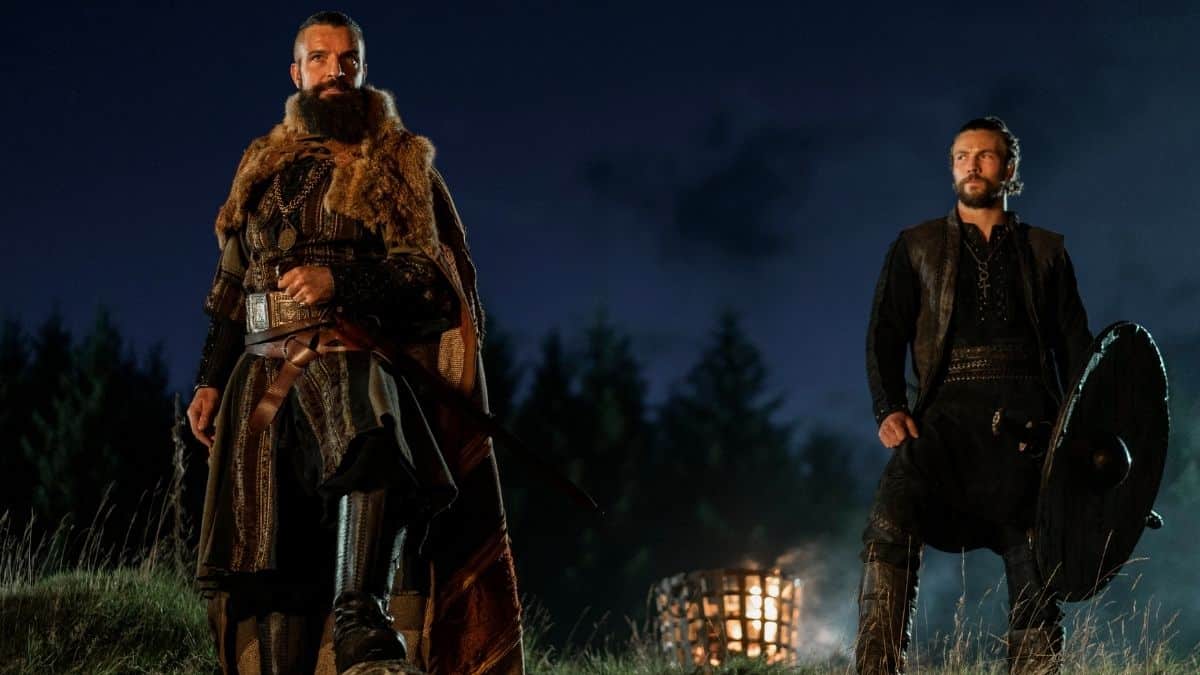
With the premiere of Netflix’s latest historical drama series, Vikings: Valhalla, viewers are starting to question some of the historical accuracies.
The new series opens with the St. Brice’s Day Massacre which was instigated by King Aethelred II (Bosco Hogan) against the Vikings. This event really happened and somewhat for the reasons stated by Aethelred.
But what about the other events portrayed in the new historical drama series?
Let’s take a look.
Prince Edmund really did battle the Vikings
In response to his father’s attack on the Vikings, then his subsequent death, his son, Prince Edmund (Louis Davison) became the king and had to deal with his father’s Viking problem.
Some of this is indeed true. However, the St. Brice’s Day Massacre occurred on the 13th of November 1002, whereas Aethelred’s death was some 14 years later. In Vikings: Valhalla, this has been condensed quite significantly.
In addition to this, Edmund had also sired children before he died only seven months into his reign.

Edmund’s death is not really explored in the historical manuscripts pertaining to this time period so the manner in which he died in the TV series is completely fabricated.
However, prior to his death, his final battle was the Battle of Assandun which ended in Edmund taking Wessex and King Canute (portrayed by Bradley Freegard in Vikings: Valhalla) taking the rest of the country. In Viking: Valhalla, this was shown as the two kings ruling side-by-side over the entirety of England, rather than them having separate areas.
With Edmund’s death, Canute exiled the remaining members of Edmund’s family, including his two sons, Edward and Edmund.

Emma of Normandy really did marry King Canute
Emma of Normandy (Laura Berlin) is a fascinating character in Vikings: Valhalla – as she was in real life.
And, yes, she really did marry King Canute after the death of her husband.
It is believed that she did so in order to have the lives of her children spared by Canute and he honored this request after they were wed.

Harald Sigurdsson really did want to become the King of Norway
Harald Sigurdsson (Leo Suter) is portrayed as the brother of Olaf Haraldsson (Johannes Haukur Johannesson).
The general gist of what was seen in Season 1 of Vikings: Valhalla also occurred in the history books. However, the TV series overlooks a large part of Harald’s life that saw him sent to fifteen years in exile in Kyivan Rus’ as well as in the Varangian Guard in the Byzantine Empire.
Perhaps this storyline will be explored in Season 2 of Vikings: Valhalla. However, that will mean that Harald will wind up on the wrong side of King Canute at some point in time as his exile was a result of a battle thanks to Canute claiming the Norwegian throne from Olaf.

Leif Eriksson did go to Norway
Season 1 of Vikings: Valhalla sees Leif Eriksson (Sam Corlett) and his sister, Freydis Eriksdotter (Frida Gustavsson) on a mission to Kattegat in Norway. Freydis had been savagely attacked by a Christian man and she was set on revenge.
This places Leif in Norway, which is where he set sail from on the fateful journey that took him to Vinland.
However, Season 1 of Vikings: Valhalla doesn’t give any hint of Leif’s discovery of America that was explored in the Saga of the Greenlanders and it looks like this event will not occur until further on down the track.
In the sagas, there is no real mention that Leif ever associated with Harald Sigurdsson. In fact, it is highly unlikely as Leif is believed to have died in 1020, whereas Harald was born in 1015.
In the Saga of Erik the Red, Leif was also converted to Christianity and it was because of this that he embarked on his journey from Norway to Greenland, so that he could convert the pagans there.
He had changed religions thanks to spending time with Norwegian King Olaf Tryggvesson, who is not to be confused with King Olaf Haraldsson in the TV series.

Freydis never sought revenge against Gunnar
The Viking sagas speak of Freydis Eriksdotter in two particular tales. Both times, it is directly involving her travels to Vinland.
At no time is she ever associated with a man named Gunnar. However, there is certainly an instance where she causes the death of someone – two men, in fact.
In the Saga of the Greenlanders, Freydis has a run-in with two Norwegian men, Helgi and Finnbogi. After some quarreling Freydis convinced her husband, Thorvard to kill the men.
It is unclear in the saga as to why Freydis decided to kill the men but it certainly isn’t suggested that it had anything to do with religion. However, there is some suggestion that the men may have attacked Freydis, according to her account.
Freydis is certainly referred to as pagan in the sagas so this part of Vikings: Valhalla certainly rings true but there was very little spoken of regarding her spiritual journey.
Vikings: Valhalla blends fact and fiction
As you can see from the historical details above, Vikings: Valhalla takes a lot of actual history but then bends and twists it to get to its own narrative.
Some of the time this is needed as very little is contained in the sagas and historical texts regarding what actually happened, giving the writers creative license to fill in the blanks.
Other times, the facts have definitely been changed in order to fit their own narrative – but isn’t that what the history books do anyway? Most of what is read from history has been recorded by the victors and, therefore, is open to interpretation.
Season 1 of Vikings: Valhalla is currently streaming on Netflix.